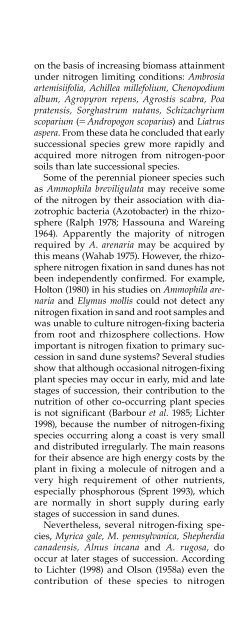The Biology of Coastal Sand Dunes M. Anwar Maun - Inecol
The Biology of Coastal Sand Dunes M. Anwar Maun - Inecol
The Biology of Coastal Sand Dunes M. Anwar Maun - Inecol
You also want an ePaper? Increase the reach of your titles
YUMPU automatically turns print PDFs into web optimized ePapers that Google loves.
on the basis <strong>of</strong> increasing biomass attainment<br />
under nitrogen limiting conditions: Ambrosia<br />
artemisiifolia, Achillea millefolium, Chenopodium<br />
album, Agropyron repens, Agrostis scabra, Poa<br />
pratensis, Sorghastrum nutans, Schizachyrium<br />
scoparium (= Andropogon scoparius) and Liatrus<br />
aspera. From these data he concluded that early<br />
successional species grew more rapidly and<br />
acquired more nitrogen from nitrogen-poor<br />
soils than late successional species.<br />
Some <strong>of</strong> the perennial pioneer species such<br />
as Ammophila breviligulata may receive some<br />
<strong>of</strong> the nitrogen by their association with diazotrophic<br />
bacteria (Azotobacter) in the rhizosphere<br />
(Ralph 1978; Hassouna and Wareing<br />
1964). Apparently the majority <strong>of</strong> nitrogen<br />
required by A. arenaria may be acquired by<br />
this means (Wahab 1975). However, the rhizosphere<br />
nitrogen fixation in sand dunes has not<br />
been independently confirmed. For example,<br />
Holton (1980) in his studies on Ammophila arenaria<br />
and Elymus mollis could not detect any<br />
nitrogen fixation in sand and root samples and<br />
was unable to culture nitrogen-fixing bacteria<br />
from root and rhizosphere collections. How<br />
important is nitrogen fixation to primary succession<br />
in sand dune systems? Several studies<br />
show that although occasional nitrogen-fixing<br />
plant species may occur in early, mid and late<br />
stages <strong>of</strong> succession, their contribution to the<br />
nutrition <strong>of</strong> other co-occurring plant species<br />
is not significant (Barbour et al. 1985; Lichter<br />
1998), because the number <strong>of</strong> nitrogen-fixing<br />
species occurring along a coast is very small<br />
and distributed irregularly. <strong>The</strong> main reasons<br />
for their absence are high energy costs by the<br />
plant in fixing a molecule <strong>of</strong> nitrogen and a<br />
very high requirement <strong>of</strong> other nutrients,<br />
especially phosphorous (Sprent 1993), which<br />
are normally in short supply during early<br />
stages <strong>of</strong> succession in sand dunes.<br />
Nevertheless, several nitrogen-fixing species,<br />
Myrica gale, M. pennsylvanica, Shepherdia<br />
canadensis, Alnus incana and A. rugosa, do<br />
occur at later stages <strong>of</strong> succession. According<br />
to Lichter (1998) and Olson (1958a) even the<br />
contribution <strong>of</strong> these species to nitrogen<br />
THE SAND DUNE ENVIRONMENT 35<br />
accumulation is negligible and thus the gradual<br />
build up <strong>of</strong> nitrogen in the soil depends on<br />
the life history processes <strong>of</strong> a species (Walker<br />
et al. 1986), acquisition <strong>of</strong> atmospheric inputs<br />
and build up <strong>of</strong> organic matter over time.<br />
<strong>The</strong> acquisition <strong>of</strong> nutrients by dune plants<br />
is also facilitated by their association with<br />
mycorrhizal fungi. <strong>The</strong> primary reason for the<br />
increased uptake <strong>of</strong> macro- and micronu trients<br />
is the exploitation <strong>of</strong> increased soil volume by<br />
extra-matrical mycelium <strong>of</strong> the arbuscular<br />
mycorrhizal (AM) fungi. <strong>The</strong> hyphae are more<br />
efficient than plant roots in the absorption <strong>of</strong><br />
soil nutrients. More details are presented in<br />
Chapter 9.<br />
2.12.2 Phosphorous cycle<br />
<strong>The</strong> second most important nutrient in sand<br />
dunes is phosphorous. Unlike nitrogen, phosphorous<br />
does not occur in the atmosphere as<br />
a gas. <strong>The</strong> primary source <strong>of</strong> phosphorous in<br />
sandy substrates is the weathering <strong>of</strong> min erals<br />
such as apatite (Ca 5(PO 4) 3X where X may be<br />
hydroxide [OH], chlorine [Cl] or flourine [F]).<br />
Since the amount <strong>of</strong> apatite in sand is very low,<br />
coastal sand dunes are deficient in P (Fig. 2.12).<br />
Nevertheless, atmosphere does make a small<br />
contribution to the overall input <strong>of</strong> phosphorous<br />
from aerosol spray from oceans, lakes and<br />
rivers, fine dust particles from volcanic ash,<br />
rocks and soil, material <strong>of</strong> organic origin such<br />
as smoke, ash, fine litter, humus, pollen grains<br />
and combustion <strong>of</strong> fossil fuels. Estimates<br />
<strong>of</strong> total phosphorous input from the atmosphere<br />
range from 0.07 to 1.7 kg ha –1 year –1<br />
(Newman 1995). This input is very small, but<br />
it is extremely important for plants in sand<br />
dune systems with little or no phosphorous at<br />
the start <strong>of</strong> primary succession.<br />
In a sand dune chronosequence along Lake<br />
Michigan, the concentration <strong>of</strong> phosphorous<br />
in the upper mineral soil increased to a<br />
maximum until about 345 years but a drastic<br />
decline occurred from 345- to 485-yearold<br />
dunes (Lichter 1998). At 2375 years <strong>of</strong> age<br />
the P levels were even lower than at 25 years,

















